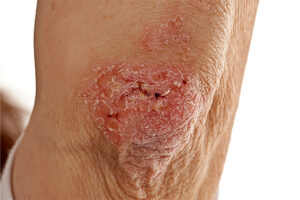Dermatology
Plaque Psoriasis
Challenges in the Treatment of Palmoplantar Psoriasis
Palmoplantar psoriasis can be a potentially disabling variant of psoriasis, with symptoms primarily involving the palms of the hands and/or soles of the feet. It is a therapeutically challenging condition and often causes greater physical discomfort and functional disability than plaque psoriasis that is limited to other areas of the body.
Although palmoplantar psoriasis may cover only a small percentage of a patient’s body surface area, it can have a significant impact on the patient’s health-related quality of life. There is no universally accepted definition of palmoplantar psoriasis, but it should be considered its own entity and not a part of a larger presentation of psoriasis involving other parts of the body. I personally consider a patient to have palmoplantar psoriasis when 90% of their psoriasis appears on the palms, soles, or both.
Palmoplantar psoriasis is more challenging to treat than typical plaque psoriasis, and patients with palmoplantar psoriasis typically have lower treatment response rates than the response rates that are seen in clinical trials for patients with plaque psoriasis. Palmoplantar pustulosis is another version of psoriasis of the hands and feet, where pustules are also present. Treatment can be even more challenging for these patients.
The majority of our available agents are less efficacious for palmoplantar psoriasis, and patients generally experience higher rates of treatment failure. In my opinion, informing patients of this consideration at the outset of discussions is one of the most important aspects of treating palmoplantar psoriasis. If patients are aware from the outset that we might need to try 2 or 3 therapies before we achieve treatment success, it helps to set realistic expectations, and it may help with treatment adherence.
Treatment goals for palmoplantar psoriasis may differ from those for other forms of plaque psoriasis. Phototherapy with or without a concomitant retinoid or psoralen is a potential option, but it is important to keep in mind that many patients may eventually require treatment with additional systemic medications. Ultimately, both patient and physician preferences will play an important role in developing an individual patient’s treatment plan. I have personally had good success with agents such as methotrexate and apremilast, as well as with JAK inhibitors, although it is important to note that there is no standardized treatment algorithm for palmoplantar psoriasis.
Again, setting expectations with patients up front regarding therapeutic challenges in palmoplantar psoriasis may help with treatment adherence if multiple therapies are needed. Future studies are needed to further assess therapeutic options and their outcomes for this debilitating presentation of psoriasis.
Gottlieb AB, Kubanov A, van Doorn M, et al. Sustained efficacy of secukinumab in patients with moderate-to-severe palmoplantar psoriasis: 2·5-year results from GESTURE, a randomized, double-blind, placebo-controlled trial. Br J Dermatol. 2020;182(4):889-899. doi:10.1111/bjd.18331
Kt S, Thakur V, Narang T, Dogra S, Handa S. Comparison of the efficacy and safety of apremilast and methotrexate in patients with palmoplantar psoriasis: a randomized controlled trial. Am J Clin Dermatol. 2021;22(3):415-423. doi:10.1007/s40257-021-00596-6
Merola JF, Qureshi A, Husni ME, et al. Underdiagnosed and undertreated psoriasis: nuances of treating psoriasis affecting the scalp, face, intertriginous areas, genitals, hands, feet, and nails. Dermatol Ther. 2018;31(3):e12589. doi:10.1111.dth.12589
Miceli A, Schmieder GJ. Palmoplantar psoriasis. In: StatPearls. StatPearls Publishing. Updated August 8, 2023. Accessed August 30, 2023. https://www.ncbi.nlm.nih.gov/books/NBK448142/
Sanchez IM, Sorenson E, Levin E, Liao W. The efficacy of biologic therapy for the management of palmoplantar psoriasis and palmoplantar pustulosis: a systematic review. Dermatol Ther (Heidelb). 2017;7(4):425-446. doi:10.1007/s13555-017-0207-0
Spencer RK, Jin JQ, Elhage KG, et al. Comparative efficacy of biologics and oral agents in palmoplantar psoriasis and palmoplantar pustulosis: a systematic review and network meta-analysis of randomized clinical trials. J Am Acad Dermatol. 2023;89(2):423-425. doi:10.1016/j.jaad.2023.04.043
Terui T, Okubo Y, Kobayashi S, et al. Efficacy and safety of apremilast for the treatment of Japanese patients with palmoplantar pustulosis: results from a phase 2, randomized, placebo-controlled study. Am J Clin Dermatol. 2023;24(5):837-847. doi:10.1007/s40257-023-00788-2
Timotijević ZS, Trajković G, Jankovic J, et al. How frequently does palmoplantar psoriasis affect the palms and/or soles? A systematic review and meta-analysis. Postepy Dermatol Alergol. 2019;36(5):595-603. doi:10.5114/ada.2019.89508











